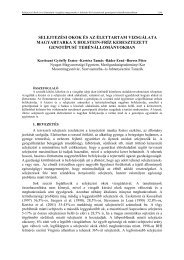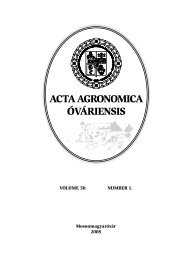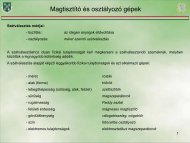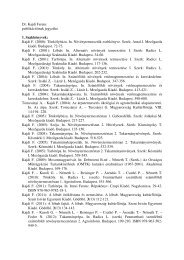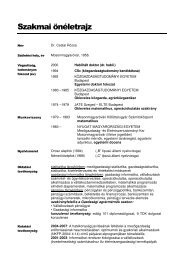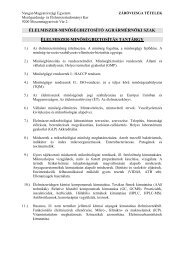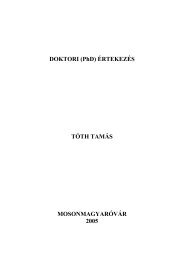teljes anyag - Nyugat-Magyarországi Egyetem Mezőgazdaság
teljes anyag - Nyugat-Magyarországi Egyetem Mezőgazdaság
teljes anyag - Nyugat-Magyarországi Egyetem Mezőgazdaság
Create successful ePaper yourself
Turn your PDF publications into a flip-book with our unique Google optimized e-Paper software.
56N. Varga – E. Bertalanné Várallyay – L. Salamon:Table 2. is a summary of herd data. It clearly shows that the 30 farms kept 466 cows onaverage. The average service index (A.I.) was 2.4 and in 2002 the calving interval periodwas 409 days long on average. These fertility problems are considerably higher than optimalespecially those referring to the calving interval period. Stock health problems included firstof all sub-clinical mastitis and placenta retention, but metritis and clinical mastitis werearound 10%. So mastitis (clinical and sub-clinical together) hit the stock greatly (22.6%).Foot diseases came lower. Dairy farmers say that foot diseases and lameness might becaused by unfavourable floor and bedding conditions. Therefore clawing should be donetwice a year in order to eliminate foot diseases in dairy farms.Table 2. A summary of average health indices of dairy farmsin the West-Transdanubian RegionDescriptionAverageAverage number of dairy cows 466Average number of in-milk cows 368Service (A.I.) index 2.4Calving interval period (days) 409Most frequent diseasesFoot diseases (%) 3.0Placenta retention (%) 12.4Metritis (%) 9.6Clinical mastitis (%) 9.5Sub-clinical mastitis (%) 13.1Number of culled cows because of disease (%) 20.1The average rate of culling (owing to the disease) was higher than 20% – calculating witha culling rate of 25–30% on average – shows that only a few cows can be involved intobreeding from the stock, so the selection stress for the sake of genetic improvement isquite low. The results of the questionnaire show that acetonaemia (especially sub-clinical)and fat liver are the main causes of high rate placenta retention and metritis, which can beattributed to feeding failures. In case of metabolic problems we should not only mentionfood quantity but quantitative and qualitative feeding as well that are needed for propermilk performance. Feeding should be done according to seasons, to the metabolic profileand performance of the cows. Lower culling loss can be observed because of the displacementof the rennet, which is a result of feeding failures mostly.Based on the questionnaires from 30 dairy farms we can say that sub-clinical mastitis(13.1%) was the most frequent disease of the stocks, placenta retention (12.4%) came lowerfollowed by clinical mastitis (9.5%) and foot diseases (3%).




